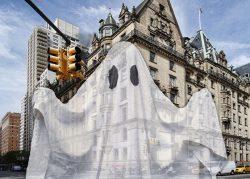 Kate Spade’s UES co-op sells for $5.8M
Kate Spade’s UES co-op sells for $5.8M
Trending
Exec’s Jenga building suicide doesn’t figure to hurt sales
How notorious events at a property affect real estate transactions

When Gustavo Arnal, the chief financial officer of Bed Bath & Beyond, died by suicide Sept. 2 by jumping from the 18th floor of 56 Leonard Street, the news spread quickly across social and traditional media.
Not only was Arnal a top executive at a major retailer, but the Tribeca condominium where he perished, known colloquially as the “Jenga tower” for its unusual design, has some of the city’s priciest apartments, with sales routinely closing for tens of millions of dollars.
Arnal’s shocking death raises the question of whether the tragedy will become an obstacle for agents selling units in the high-profile property, where prospective buyers have the choice to live just about anywhere they please.
The answer, observers say, is probably not. Such properties tend to overcome unfortunate events that occur there.
“They clean them up, they put them on the market and they sell,” real estate attorney Adam Leitman Bailey said. “Nothing’s going to get in the way of [people] buying the best apartment they can. Death’s certainly not going to get in their way.”
Two factors help apartments avoid or overcome the stain of a newsmaking death, Leitman Bailey noted. Unlike in other states, agents in New York need not disclose that a death happened on the property and, until fairly recently, newspapers rarely included a home’s address in their coverage of such events.
Read more
 Kate Spade’s UES co-op sells for $5.8M
Kate Spade’s UES co-op sells for $5.8M
 Joan Rivers’ longtime UES penthouse hits the market for $38M
Joan Rivers’ longtime UES penthouse hits the market for $38M
 Hallowed halls: The most haunted buildings in NYC
Hallowed halls: The most haunted buildings in NYC
Consider the Upper East Side co-op at 850 Park Avenue, where designer Kate Spade was found dead of suicide. It sold for $5.8 million just months after being put on the market for $6.35 million.
Heath Ledger’s 2008 overdose at 421 Broome Street didn’t stop the owners of its triplex penthouse from flipping it for a $14 million profit. The $49 million deal was one of the priciest of last year. (Ledger had been renting a pad on the fourth floor.)
There are exceptions. The single-family Long Island home where grisly murders in 1974 gave rise to the popular film and novel “The Amityville Horror” was frequently visited by gawkers and became difficult to sell, though it did fetch $605,000 in 2017.
Among the most infamous events associated with a New York City residential property was John Lennon’s assassination in 1980 outside the Dakota, 1 West 72nd Street, where he lived. Countless Beatles fans have made pilgrimages to the site of his death, which is not exactly a selling point for the co-op.
Still, Cody Vichinsky, whose brokerage Bespoke is marketing units in the building, said, “The fame of the building is more important than the fame of its tenants.”
More generally, he said, the impact of notable deaths on a building can be circumstantial.
“People have empathy for the situation, they don’t want the juju sometimes,” Vichinsky said. “But that has nothing to do with the building in and of itself.”
The project at 56 Leonard Street has been a hit with buyers, but its developer, the Alexico Group, endured a tough start. The Manhattan-based company, headed by Izak Senbahar and Simon Elias, had to bring in the national real estate firm Hines as a co-developer after the financial crisis pushed the condominium off schedule by nearly six years.




